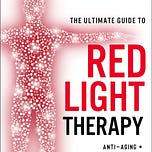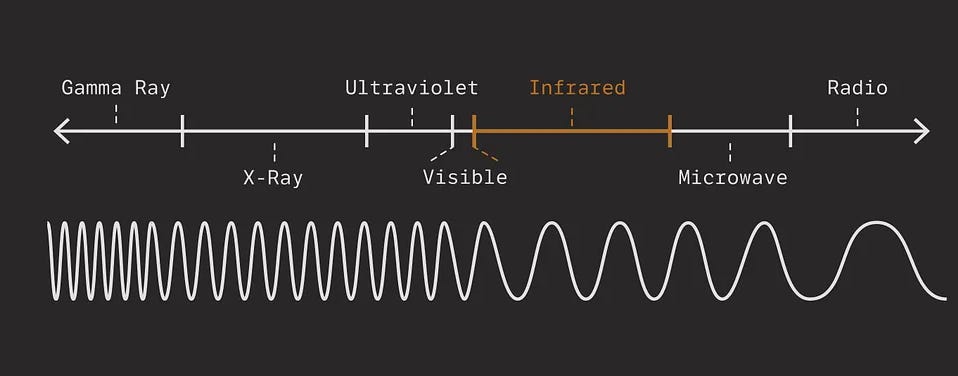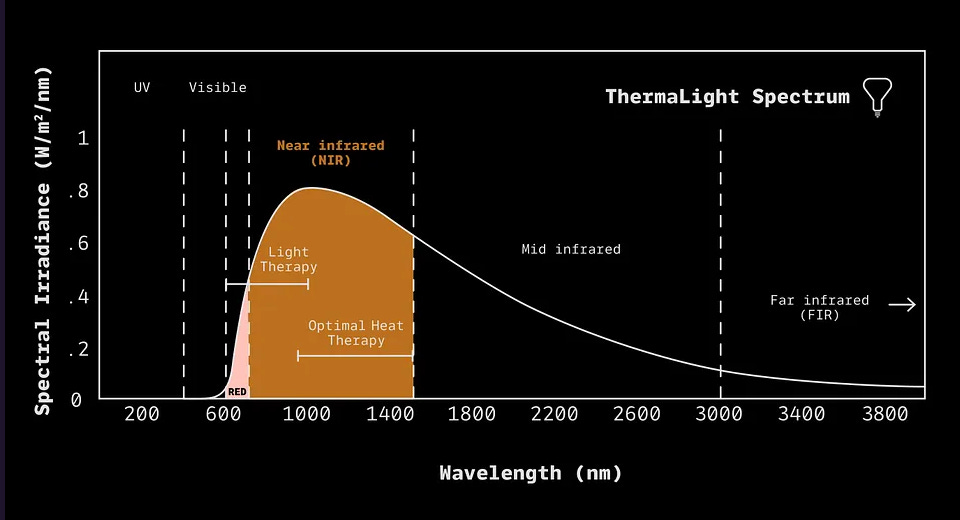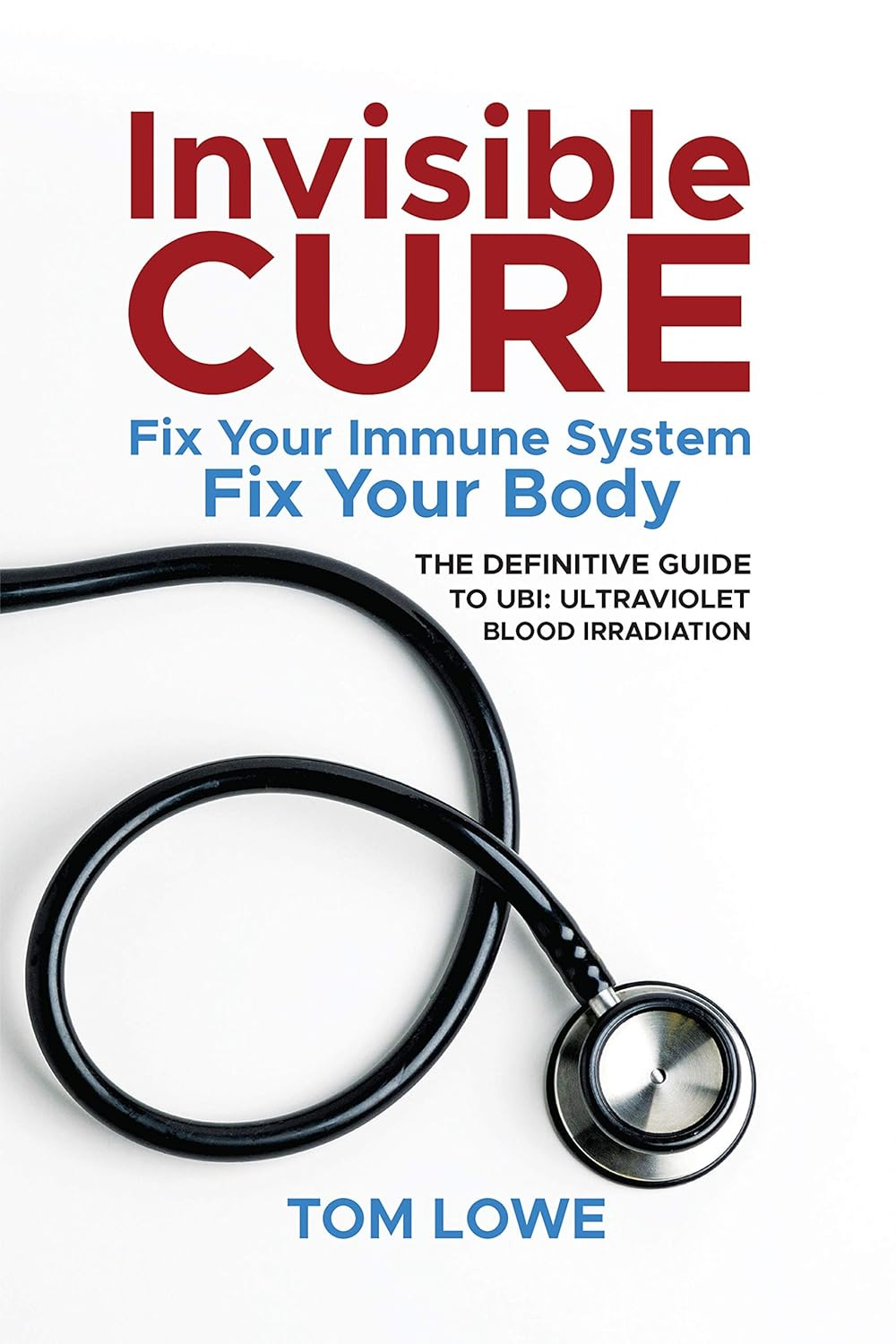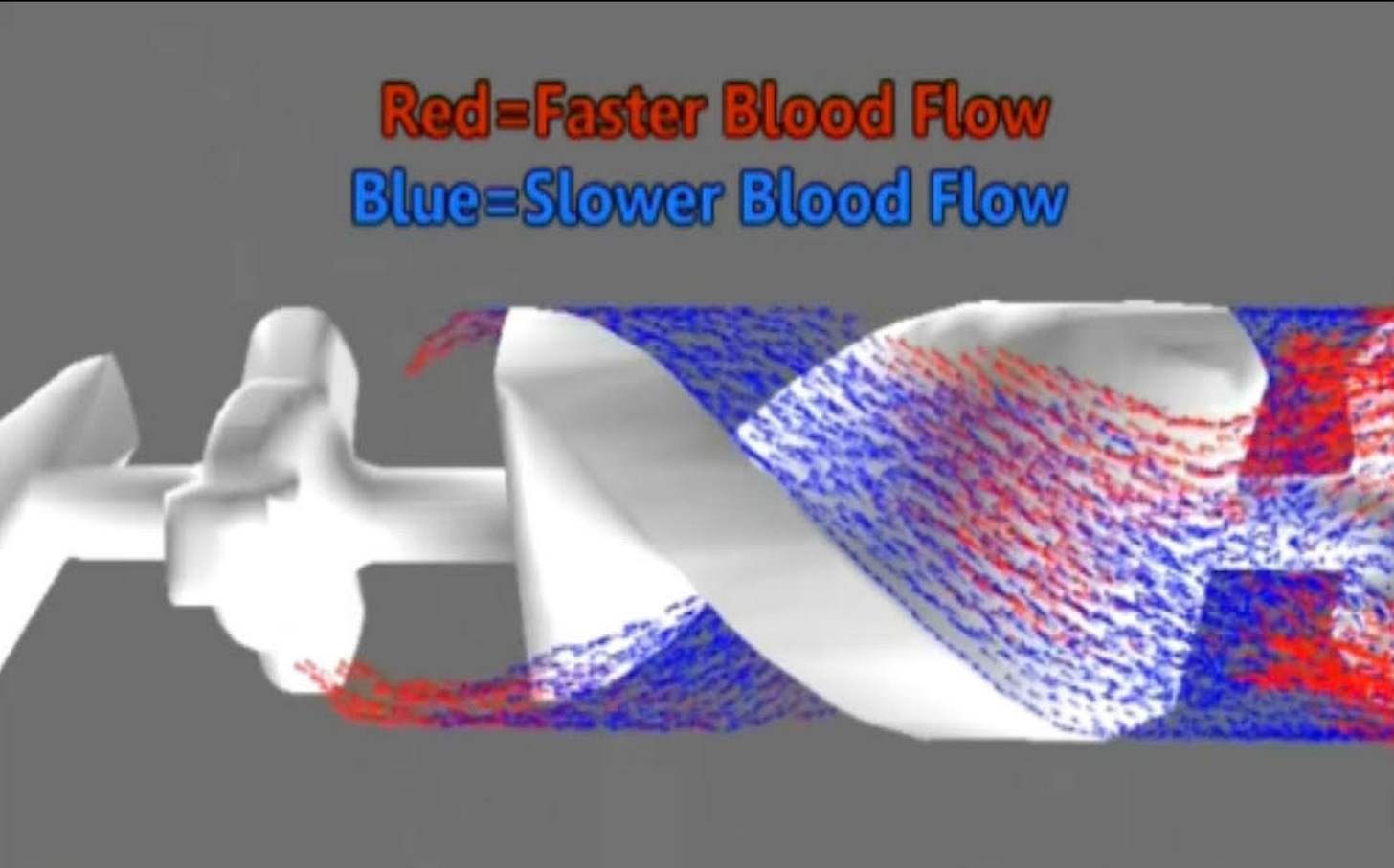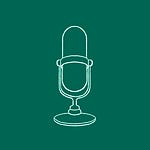Study hard what interests you the most in the most undisciplined, irreverent, and original manner possible. —Richard Feynman
Part 1: Near-infrared light treatments
I read this excellent, heavily referenced book to prepare this post. It has 3600 Amazon ratings averaging 4.5 stars. It contains technical information but is well-written for those who are not technically minded. You don't need to learn about wattage, mitochondria, nitric oxide, or cytochrome c oxidase to enjoy reading it. If you decide to get an infrared light, you must read this book. The Kindle version is $2.99.
Author Whitten recommends certain red lights, but Sauna Space, which sells the red light sauna that I use, is not at the top of his list. I respect Mr. Whitten’s opinions, but as always, make your own decisions.
A chart showing the electromagnetic spectrum follows. The left side is the short, high-frequency waves with far more energy, while the right is the long waves used for communication. The narrow visible light band is in the middle; ultraviolet and infrared are on either side of this. Exposure to these two wavelengths improves health.
Even though ultraviolet (UV) barely penetrates the skin, its “UV-B” part stimulates vitamin D synthesis. In contrast, near-infrared (NIR) passes two inches into the body—even into the brain. Depression, anxiety, and seasonal affective disorder may be relieved, along with much more.
The following is a magnified part of the top diagram:
The curve above is the spectrum emitted by Sauna Space’s infrared lights. The parts of the visible and near-infrared spectrum that promote health are shown in orange. Thousands of studies back this claim.
Mr. Whitten supports this: “Based on the bulk of the research, you want: 630-680nm (the optimal healing spectrum of visible red light), 800 to 880nm (the optimal healing spectrum of near-infrared), or a combination of both.” Sauna Space’s bulbs cover these sweet spots. Its bulbs are powerful enough that you can be up to three feet away and still get strong effects. A four-bulb setup is $1500.
Far infrared produces heat. The graph above shows this under the curve to the right of the orange area. An enclosed space is needed to make this work best.
Warming has separate, beneficial effects. Any holistic doctor will tell you that when you sweat, you detoxify. Research on 2300 Finnish men using saunas showed that their lifespans were extended. They averaged at least 14 minutes four days a week. This was an observational study, so it is suggestive but not conclusive.
In contrast, thousands of studies support dozens of healthy effects for the near-infrared and red light shown in the dark and light orange areas above. These radiation effects are far more well-established than the benefits of heat—and you do not have to cook yourself at 160 degrees.
Whitten tells you what works best. He says, “99% of the red light therapy products being sold in major outlets online are a waste of money… Virtually ALL of these devices—even the ones that cost hundreds of dollars—are grossly underpowered, too small, and ultimately, ineffective or very time-consuming to use, or both.” Some of his recommended lights are under $500.
He also writes that optimal exposure to near-infrared light may be shorter than what is best for a sauna. Depending on your device, only a few minutes every other day may be optimal for your IR exposure. In contrast, 20 minutes four days a week at 160 to 170 degrees Fahrenheit might be best for heat. Ari may be correct, but usage precision like this is beyond the interests or inclinations of most people—including me.
Ari Whitten’s book describes how NIR treatment benefits:
Injuries (sprains, strains, cuts, burns, fractures, whiplash, etc.). He says to use it as soon as possible.
Sleep enhancement/melatonin production.
Noninvasive body contouring: “Research has shown that LLLT [low-level laser treatment, a related modality] is effective in reducing overall body circumference measurements of specifically treated regions, including the hips, waist, thighs, and upper arms, with recent studies demonstrating the long-term effectiveness of results. The treatment is painless, and there appears to be no adverse events associated with LLLT.”
Medical syndromes:
Traumatic brain injury
Spinal cord injury
Peripheral nerve injury
Painful diabetic neuropathy
Alzheimer’s and Parkinson’s disease
Cognitive performance and memory
Improvement of osteoarthritis
Hashimoto’s hypothyroidism
Fibromyalgia and chronic fatigue
Enhancing recovery from exercise with increased muscle gain, fat loss, performance, strength, and endurance.
Regrowing hair in men after hair loss
Speeding up wound healing
Increasing energy levels
Decreasing inflammation
Improving eye health, including age-related macular degeneration
Improving cognitive performance
Ari’s tips for light usage in his own words
Many light devices come with a door-hanging kit. If you choose to use that, you’ll be standing (or sitting in a chair) next to the device. Many people do it this way. I personally almost always use mine while lying down. I position the lights on the ground and lay next to them either on my side, back, or front to treat the targeted area. I just find it more relaxing (than standing) to lie down while doing it.
Mostly, I tell people they can use these things for 10 or 20 minutes a day, and it’ll have major benefits and will be extremely unlikely to have any ill effects.
My hunch is that optimal treatment times are probably once every other day to once per day at the most. I personally do it every other day, because that’s what I believe will turn out to be optimal.
A number of studies … have shown that by overdoing the dose, you negate the benefits. If anything, the research indicates that smaller, more conservative doses are superior to very large doses… I know some people who have used red light therapy for decades and believe that it’s very hard to realistically overdo it in a way that negates the benefits…
Moving further away than about 3 feet from the light (as a general rule) and you’ll get little to no effect on anything below the surface of the skin. (And that’s using a powerful light. Many lights won’t provide effective doses beyond just 12” away.) …The sweet spot is generally between six and thirty-six inches.
Why does it work?
The fundamental reason that red and near-infrared light [Yoho note: and ultraviolet blood irradiation (UBI), see below] have so many incredible benefits on our health is because they are correcting a deficiency. We should be getting plenty of red and near-infrared light from the sun, but since we’re not, we can apply a device in a targeted way to give us that light “nutrient” and get profound benefits from it…
While most other wavelengths of light (such as UV, blue, green, and yellow light, etc.) are mostly unable to penetrate the body and stay in the layers of the skin, near-infrared light and red light can reach deep into the human body (several centimeters, and close to 2 inches, in some cases) and can directly penetrate the cells, tissues, blood, nerves, rods and cones of the eyes, the brain, and into bones. [Yoho note: UBI permits deep penetration using the other method I describe below.]
Ari concludes
Today, research into the power of red light to improve health and treat disease is really gaining momentum. We are learning that red and near-infrared light therapy can benefit virtually every system of the body and can even improve the way you look—it can help you to shed inches of fat, reduce the signs of aging, regrow hair, increase the results you get from your workouts, reduce pain, speed healing, boost hormonal health, and lower inflammation.
Red and near-infrared light therapy is offering a new, completely safe, and noninvasive alternative to various anti-aging skin surgeries, Botox injections, and more abrasive chemical peels. And for combating skin aging, red and near-infrared light is an extraordinarily powerful tool.
After you get one of these lights, you can immediately start using it to: Increase your energy, make your skin healthier, get rid of cellulite, speed up fat loss, improve muscle recovery and athletic performance, improve mood and cognitive function, increase muscle size and strength, speed healing from injury, and improve metabolic and hormonal health.
Whitten tells you which lights he recommends. Most manufacturers give customers 15 percent off when using his affiliate code, which more than reimburses them for the book. Whitten is also paid for each purchase--a conflict of interest. To his credit, he discloses this, and his sincerity shines through for me. See what you think.
Part 2: Ultraviolet Blood Irradiation (UBI) bent my thinking
This consists of drawing blood and running it through a vial that is transparent to the ultraviolet-A (320 to 400 nanometers) that is used for UBI. The blood is then replaced back into the body. The first studies were on dogs that were purposely infecting with staph bacteria. The researchers treated their entire blood volume, but they all died within a week.
After several years of murdering dogs, the experimenter accidentally used only a tiny amount of blood from one of the animals. It survived, and the infection was cured. This result was replicated thousands of times in humans, and UBI evolved into an accepted therapy.
Only about sixty cc of blood is used currently. It is drawn out of a vein, mixed with heparin so it does not clot, and passed through a transparent quartz chamber called a “cuvette.” As this happens, ultraviolet (not infrared) irradiation is shone through the blood and then replaced into the body. Ultraviolet is on the far side of visible light from IR; see the top spectrum diagram.
The inside of the cuvette has specially designed protrusions that create turbulence and push the blood to the sides of the transparent device. Since UV wavelength penetrates so minimally, this is needed to maximize the radiation contact with blood.
Because ultraviolet penetration of human tissues is so minimal, this clumsy procedure is necessary to expose the blood to enough of these wavelengths to produce clinical results.
UBI is now available in most major US cities. The machines only cost about $5000, so the procedure should be only a few hundred dollars. Most clinical results occur after one or just a few treatments.
Invisible Cure is heavily referenced. The author spent twelve years traveling and interviewing many doctors. During this time, he went from being a disbeliever to owning a clinic and promoting the therapy.
Hundreds of thousands of patients have been treated in the 80 years since UBI was invented. Over a thousand studies have been published, and about 500 US doctors now use it. Virtually no harmful effects have ever been reported from UBI, and the efficacy rate is 60-80%. Responses have been seen in sixty diverse conditions.
Disorders that have been successfully treated with UBI
(From Invisible Cure.)
David Minkoff, MD, legendary wholistic physician: “All of our Lyme, cancer, chronic fatigue, M.S., and autoimmune disease patients receive it, and I get one every week because it improves immune health and athletic performance.”
From Africa, a case of advanced rabies: “Rabies is always fatal unless there is an intervention… The [day after the first treatment there were] signs of recovery. Another two treatments were administered within the following days… [and] he made a full recovery."
Reports of cures for cancer, tachycardia, shingles, asthma, infections, chronic pain, MS
Inactivation of snake venoms
Cures for pneumonia (viral and bacterial), peritonitis, polio, botulism, biliary disease, rheumatic fever, eye infections, viral hepatitis
Clinical Depression relief
Inflammatory and osteoarthritis
Heart disease, including vascular disorders
OB/GYN: reduction of miscarriages and stillbirths, increased fertility, success with preeclampsia, PID with sepsis
Viral infections: influenza, COVID, SARS, MERS, H1N1 viral pneumonia, viral hepatitis, Epstein-Barr, polio, viral iridocyclitis, uveitis, retro-bulbar neuritis. Shingles pain is almost always reduced after one or two treatments.
UBI studies include
Thousands of hospitalized patients were treated with UBI from the 1930s through the 1950s. Many of the records are extant, and the findings support efficacy.
A 2016 review of UBI by Michael R. Hamblin of Massachusetts General Hospital described the treatment of multidrug-resistant gram-positive and gram-negative bacteria in patients at risk of death from sepsis. He also treated Covid and pneumonia. He and his colleagues produced over 350 peer-reviewed studies.
UBI has been studied in treating pneumococcus, staphylococcus, streptococcus, and other microbes. Treatment groups recovered 5-7 days sooner. Measures of blood health improved, including an increase of nearly a third in red blood cell formation.
Chronic active hepatitis with cirrhosis study: survivorship improved
Acute rheumatic heart disease: success in 22 consecutive cases
Tuberculosis study of 222 hospitalized patients: 100% cure rate for the group with standard therapy plus UBI
Bacterial infections, 40 studies from the 1940s to 2002: osteomyelitis, strep, staph, E coli, nosocomial “superbugs,” pneumonia, meningitis, typhoid, Lyme
History
Emmet Knott was a Seattle physicist and X-ray dealer. He started experimenting in 1923 and patented his treatment in 1927. The first human experiment was performed in 1928 to treat hemolytic streptococcus. It was the same bacteria injected into dogs in the original experiments. The human patient was near death from a septic abortion. She had chills, high fever, abdominal pain, and a foul-smelling vaginal discharge. After UBI, she recovered rapidly. Other successes followed.
The 1920s were before antibiotics. Infectious disease was widespread. Heliotherapy (sunlight) was standard practice for tuberculosis. Dr. Walter Ude used this and claimed a nearly 100% cure rate for erysipelas, a superficial strep cellulitis.
Knott spent decades promoting UBI; by the 1940s, there had been 25 trials. Many studies were done in hospitals where the record-keeping was the best. The results were staggering—the procedure saved lives. Even today, many disorders that do not respond to drugs improve with ultraviolet blood irradiation.
The American Medical Association (AMA) concealed and sidelined UBI.
Morris Fishbein ran the AMA and was the chief editor of the Journal of the American Medical Association (JAMA) from 1924 to 1950. In the late 1940s and early 1950s, he tried to purchase the rights to various treatments. If the owners would not sell, he labeled them quacks. As UBI was gaining ground in many hospitals, Fishbein offered Emmet Knott $100,000 (about 1 million dollars in today’s dollars) to buy the rights to the device and perform a study supporting UBI. Knott refused.
In those days, Fishbein supported tobacco companies’ claims that their products were healthy. In return, they advertised in JAMA. Fishbein approved slogans including “More doctors smoke Camels than any other cigarette” and “Just what the doctor ordered.”
[Then, in1953,] the Congressional Investigation Committee determined that… twelve alternative treatments were actively conspired against by the AMA and organized medicine. It castigated the AMA for its dishonesty and conspiracy against non-orthodox treatments. Specific rebukes included in the Fitzgerald report had this to say: “There is reason to believe that the AMA has been hasty, capricious, arbitrary, and outright dishonest”… “Behind and overall, this is the weirdest conglomeration of corrupt motives, intrigue, selfishness, jealousy, obstruction, and conspiracy that I have ever seen.”
Do you see the patterns? Fishbein was willing to promote cigarette smoking as healthy, and tobacco companies continued this marketing for another half-century.
Despite its promise, Fishbein also discouraged light therapy. After he was labeled a fraud, he was hired by a tobacco company.
Rockefeller’s attempts to rule healthcare began during this period. He discredited holistic methods and promoted treatments that made money and could be controlled. None of these had the almost universal applicability and near-panacea qualities of UBI. Many died because the knowledge suppression limited available therapies.
It was mass murder—eugenics. But compared to the open war during the deployment of Covid and the “vaccine,” it was an amateurish, innocent era.
How does UBI work?
It theoretically destroys DNA in the virus’s and bacteria’s nuclei, preventing replication. Red blood cells are not vulnerable to this because they have no nuclei. White blood cells do, but they are a tiny minority. Even with the cuvette’s internal protrusions mixing the blood and presenting more surface area to irradiation, some estimates are that only .05 percent is exposed to the light. How could treating such a small amount of blood work so well? No one knows.
How many treatments are needed? Between 1933 and 1952, Knott’s therapy was used for thousands of patients. Many had only one treatment and recovered. Polio, acute hepatitis, pyogenic (pus-producing) infections, pneumonia, tuberculosis, pelvic inflammation (associated with pregnancy), and septicemia have all been cured after only three or four treatments.
Yoho editorial
I am stunned by how well both UBI and NIR light treatments work. The claims about each nearly mirror the other, which may mean they do the same thing. Ultraviolet blood treatment is invasive but requires far less exposure time than infrared. My strong impression is that UBI is far more effective than NIR.
Ari’s theory is that near-IR’s profound effects is likely due to our sun deprivation. UBI probably has impacts for the same reason. Our bodies are so starved for even a minimal exposure, that when we get it, dramatic improvements ensue. And we feel fantastic.
I felt sick after learning all this. My ladder has been leaning against the wrong wall my whole medical career.
NB: I did not read the primary literature, and much of it is observational. Nevertheless, the evidence favoring these treatments is credible.
Selected references
See the end of my post HERE for more, including a Mercola podcast about Sauna Space’s infrared systems. Mercola is so enthusiastic that I wonder if he has a financial interest. I believe what he says, however.
Low-Level Light Therapy: Photobiomodulation, Hamblin et al. (2018). This is a medical text.
www.InvisibleCure.com is about UBI
Persistent Spike Protein Syndrome: Rapid Resolution with Ultraviolet Blood Irradiation 09/27/2023 by Dr. Thomas Levy
Appendix: How UBI is performed today
From Ken Dillon’s Healing Photons, The Science and Art of Blood Irradiation Therapy ( 1998).
Sixty ccs of blood [about one percent of the total blood volume] are drawn and mixed with 500 IU of heparin in a 60cc syringe. A 250 ml saline bag is attached to a cuvette. After an appropriate volume is discarded, the blood is mixed into the saline (making it about a third blood; other protocols use only 20 percent). The cuvette is placed in the UBL machine, and the drip speed is set to 10ml/minute. The blood mixture returns to the patient after it goes by the light in the machine. It takes about 30 minutes.
Parting shot: A few snarky comments
Ari Whitten uses jargon to describe how light “charges the cellular battery.” His description makes sense and is referenced, but I think it is irrelevant to a patient, clinician, or casual student like me.
You may disagree with my assessment. But you may be smarter than I am, or maybe you are starstruck by “scientists.” I am not; I am contemptuous of them based on the lies they have told us over the past decades and how easily they have been bought.
I see the world through the lens of a 1900-era doctor. I am trying to learn what works by observing patients and listening to others—empiricism. After the frauds I’ve witnessed, I am contemptuous of academics, the bribed journals, and their “randomized controlled trials.” I do not give a damn about theories or mechanisms, either.
In our post-science era, only experience is clean; only empiricism remains. To dismiss patient stories as “anecdotal” is a baldfaced globalist lie.
If I don’t understand something after studying it, I quickly label it false. I have felt academic medicine was fraudulent for most of my career but have only recently have understood why. Here is my explanation from Butchered by “Healthcare” (2020):
Three “Blue’s Clues”—practical heuristics—will help you decipher anything.
1) The updated Golden Rule is that those with the gold make the rules, so learning the funding source explains a lot.
2) If you do not follow the reasoning, someone is likely lying to sell you something. You are as smart as the storyteller, so do not let them fool you. This applies to financial advisors and lawyers as well as to medical studies. You do not need to be an academic to judge complex data—in fact, learning too much detail obscures the truth.
3) Controversy, confusion, and contradictory evidence about small numbers prove that whatever it is does not work. Do not fall into the trap of believing “reasonable people disagree” or “the science is developing.” Always remember Rule 1—follow the money.
The following are examples of ideas that I quickly dismiss. First is Ari quoting another source:
“Thus, we feel justified to assume that the [red/NIR] irradiation upregulates ATP turnover by reducing the viscosity of the nanoscopic interfacial water layers which seem to control the efficiency of the mitochondrial nanomotor…
Based on their findings, the researchers of this 2015 study suggest that it may be due (partly or mostly) to how light affects the water viscosity in the mitochondria and allows for easier rotation of the ATP synthase pump.”
This refers to a fashionable recent theory. I heard enough gibberish like this in school, so give me a break now.
The following is interesting. Although Whitten cites references, I remain doubtful.
A recent study has actually found that other organisms—including mammals that are biologically very similar to humans (like rodents and pigs)—have now been shown to be capable of taking up chlorophyll metabolites into their mitochondria, and using those metabolites to capture sunlight energy and amplify cellular energy production! The research suggests that some animals can use these chlorophyll metabolites to speed up the rate of energy production and increase the overall volume of ATP produced by fairly large amounts in many cases… Here is a chunk of the abstract from this fascinating study… “Sunlight is the most abundant energy source on this planet. However, the ability to convert sunlight into biological energy in the form of adenosine-59-triphosphate (ATP) is thought to be limited to chlorophyll-containing chloroplasts in photosynthetic organisms. Here we show that mammalian mitochondria can also capture light and synthesize ATP when mixed with a light-capturing metabolite of chlorophyll.”
With all the stories we must now ignore, these ideas seem like prime candidates.

